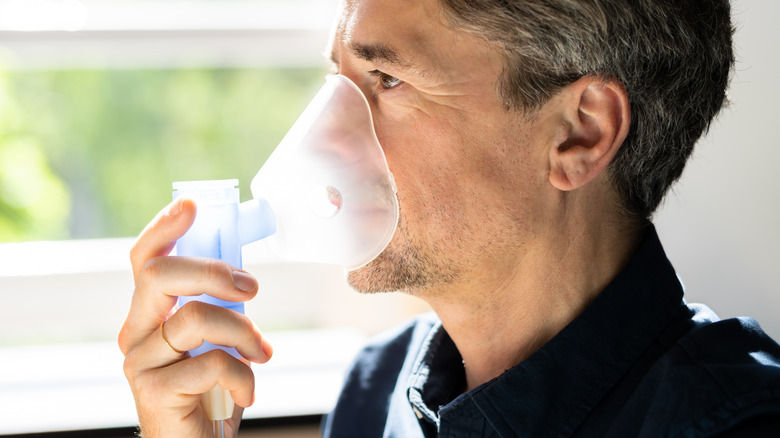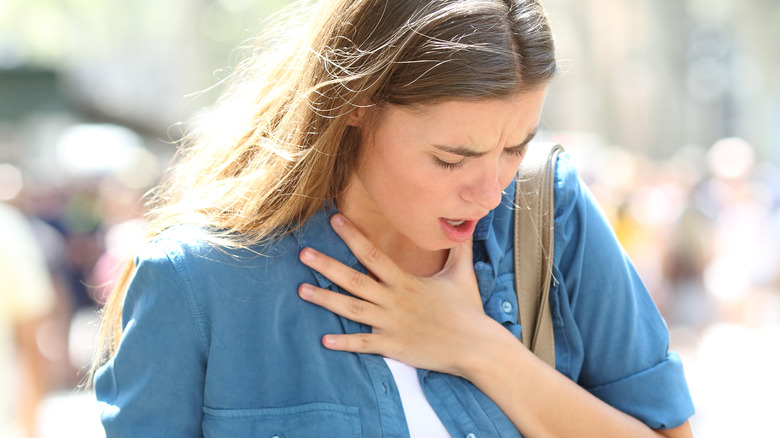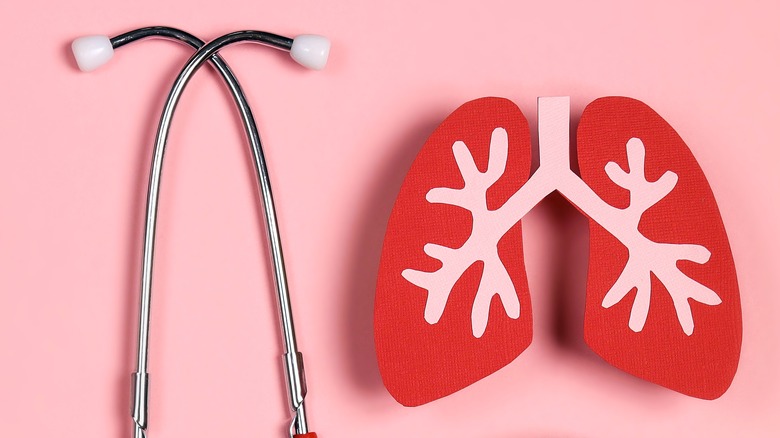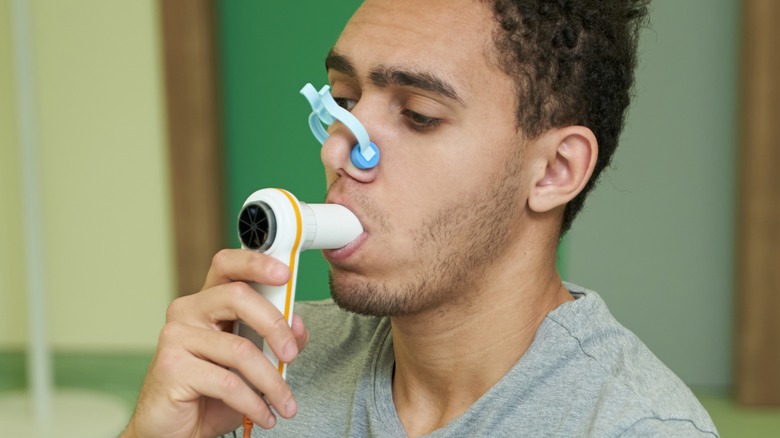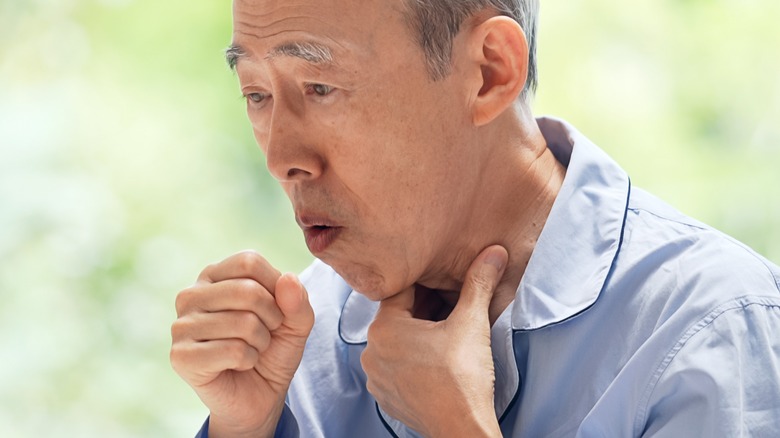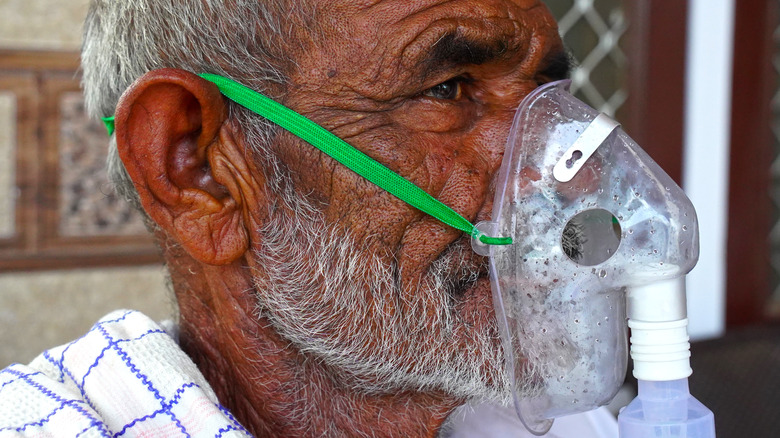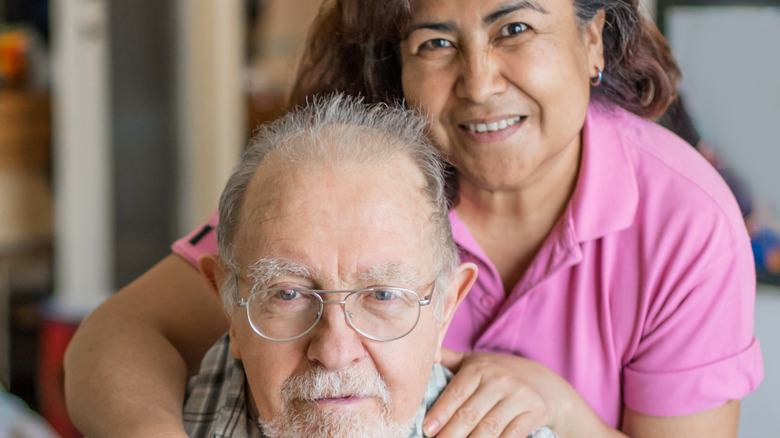COPD Explained: Causes, Symptoms, And Treatments
Chronic obstructive pulmonary disease (COPD) is a broad term for a few types of specific lung disorders (via the COPD Foundation). It is a debilitating condition that develops over time due to irritations that harm your lungs and airways. Although different lung conditions fall under the COPD category, they are similar in that they are not curable but can be treated. According to the Centers for Disease Control and Prevention (CDC), emphysema and chronic bronchitis are specific disease examples referred to as COPD. These conditions cause airflow obstruction and breathing difficulties that can progress over time.
Furthermore, approximately 16 million Americans have been diagnosed with COPD and experience symptoms related to shortness of breath. The CDC also states that millions of people go undiagnosed and untreated each year. Therefore, the actual number of people affected may be higher. Per the World Health Organization (WHO), COPD ranked third among all causes of death worldwide in 2019.
Early COPD diagnosis and treatment are crucial to long-term health and well-being. Thus, it's important to understand the disease's causes, symptoms, and treatments, and recognize its early warning signs.
Causes of COPD
Though smoking is the primary cause of COPD, nonsmokers can also acquire the disease (via the American Lung Association). Cigarette smoking accounts for approximately 85% to 90% of COPD diagnoses.
Cigarettes contain thousands of chemicals and toxins. These toxins can wreak havoc on your airway and alveoli (the tiny sacs in your lungs that store oxygen). When you stop smoking, your lungs begin to heal from the damage caused by the toxins and chemicals, which is probably the most encouraging news you can hear if you are thinking about quitting (via Medical News today).
The possibility that your environment could contribute to the development of COPD is a frightening one. You may be more at risk if you are consistently exposed to pollutants, chemicals at work, secondhand smoke, or even dust or fumes from moving vehicles (per WebMD). We are all somewhat exposed to toxins and air pollutants. Although this may be true, it is impossible to live in a bubble.
So what should you do if you live in a polluted area or if your job exposes you to more pollution than usual? The American Lung Association advises several different precautions, including exercising inside when air pollution levels are high and reviewing your local area's daily air quality report. The group also recommends avoiding burning trash or other materials, and using electric equipment whenever possible. You can also participate in local campaigns to promote clean air.
Know the symptoms and risk factors of COPD
It is essential to understand the symptoms and risk factors of COPD. When the condition is discovered early on, treatment and prognosis are far more controllable. The CDC states that early signs may be minor and undiscovered until lung damage has advanced. Due to this, early detection may be challenging.
Many people dismiss early symptoms such as shortness of breath during regular activity. After all, it's easy to ascribe them to one's age or lack of physical activity. Still, the American Lung Association warns against ignoring any changes in your breathing that last more than a few weeks. It would help if you didn't disregard further symptoms, including a persistent cough with increased mucus production, recurrent respiratory infections, fatigue, or wheezing. Visit your doctor for a complete evaluation if you have these symptoms.
Furthermore, a family history of smoking and COPD are risk factors, according to a 2011 study in Chest. While genetics can predispose you to develop COPD, it is very rare (via the Mayo Clinic). People who live or work in environments with greater levels of pollutants are more likely to be exposed to risk factors such as fumes, chemicals, and pollutants. In those situations, it is difficult to avoid them altogether.
COPD stages
According to the COPD Foundation, many factors are considered to stage the disease than just the results of lung function tests. Your current health status, as well as any other comorbidities and family history, must be considered to determine how your symptoms may progress over time.
The early stage of COPD (stage one) may sneak up on you before you realize there is a problem (per WebMD). You might have a bothersome cough that comes and goes, which may or may not produce mucus. After exertion, you may attribute shortness of breath to being out of shape or aging, leaving stage one unnoticed and underdiagnosed. Stage two will mirror stage one. However, as the symptoms worsen, you realize this might not just be a consequence of getting older or being out of shape.
WebMD describes stage three as severe. During this stage, your symptoms will begin to affect your life and present difficulties in performing daily activities. You may notice more flare-ups or infections. Treatment and lifestyle changes can help keep you moving at this stage. End-stage COPD, also known as stage four, is considered extremely severe (via Global Allergy & Airways). Symptoms become persistent at this stage and can impact your heart, mental clarity, and decision-making. As a result, breathing is difficult, and you may need assistance with routine care.
Although there is no cure for COPD, there are treatments that can alleviate symptoms. Remember that early detection and treatment can help slow disease progression.
Testing for COPD
Many factors will be considered when diagnosing COPD. Specific tests will be performed to establish how well your lungs are functioning. According to the American Lung Association, the most common test performed is spirometry. This test is a good baseline indicator for how well your lungs work by measuring how much air you can breathe in and out of your lungs. Spirometry also assesses how hard you can push or expel air from your lungs. This test can be used to determine if your condition is worsening, or if medications are helping to improve your symptoms.
Other tests may include a chest X-ray or a CT scan of the chest. These radiographic images can aid in diagnosing COPD and may reveal pulmonary hyperinflation or bronchial wall thickening (via American Family Physician).
The Mayo Clinic also recommends blood work to determine how well your lungs oxygenate your blood and remove harmful carbon dioxide. This test is known as arterial blood gas (ABG). Your doctor or pulmonologist may also recommend additional blood tests, such as an alpha-1 antitrypsin test, to look for a genetic disorder specific to COPD If you have a family history or develop symptoms at a young age.
Can breathing exercises alleviate COPD symptoms?
According to WebMD, performing breathing exercises three to four times per day for up to ten minutes each time can help you breathe easier, with less effort, and with more oxygen.
One of the quickest ways to control and slow your breathing is through pursed lip breathing. This technique improves ventilation, keeps the airway open longer, relieves shortness of breath, and increases relaxation. This approach is helpful when engaging in an activity that makes breathing difficult (per the Cleveland Clinic).
Healthline advises giving the huff cough a try if you have mucus in your lungs. You can cough out the mucus by doing this technique without exerting too much effort. It's not as intense as a typical cough. A huff cough is performed by sitting up and taking a deep breath in, followed by three equal breaths out while saying, "ha, ha, ha."
Diaphragmatic breathing is also beneficial. According to National Jewish Health, people with COPD use accessory muscles such as the neck, back, and shoulders, which can cause pain and exhaustion. The diaphragm pulls air into the lower part of the lungs to improve oxygenation. To practice diaphragmatic breathing, sit up and place one hand on your stomach and one on your chest. Inhale deeply and slowly through your nose. You should feel your stomach move, not your chest. Relax your stomach and let the air out slowly through your mouth as you exhale.
Treatment for COPD
There are many treatment options available for COPD symptoms. Because treatment is often tailored to a patient's symptoms, no two treatment options will be the same for everyone. When discussing a treatment plan, you must collaborate with your doctor to ensure you understand how the medications work. Many prescribed medications are intended to reduce mucus production, open airways, and reduce inflammation in the lungs. Essentially, drugs function to keep your symptoms under control (via the American Lung Association).
According to the Cleveland Clinic, fast-acting bronchodilators, often known as rescue inhalers, are used to unblock airways by relaxing the muscles that constrict during flare-ups. Mucus can also be expelled more efficiently when the muscles are relaxed. When you exhibit symptoms of shortness of breath, these quick-acting inhalers are indicated for therapy. In most cases, the effects disappear after three to six hours. To minimize acute episodes of shortness of breath, you may be given a long-acting bronchodilator known as a maintenance inhaler to use regularly. Non-steroidal anti-inflammatory medications (NSAIDs) may also be prescribed, per the Cleveland Clinic. They are used to reduce inflammation in the airway. However, because these medications can take a few weeks to work, they are rarely prescribed alone. As a result of their quicker-acting nature, corticosteroids, whether in pill or inhalable form, are commonly prescribed.
Many COPD treatments come in combination forms and can help with inflammatory responses and shortness of breath. Combined medications can help decrease episodes of acute flare-ups (via Healthline).
Lifestyle changes can help
You may need to alter your lifestyle to reduce exacerbations if you have COPD. Therefore, following your doctor's advice and guidance is essential to longevity (via Healthline).
If you smoke, giving it up will improve your breathing over time, claims NYU Langone Health. Additionally, it's crucial to ensure you receive immunizations like the pneumococcal and flu shots that can help prevent infections from developing in your lungs. Your life may be extended if illnesses are prevented.
According to the COPD Foundation, sustaining good health and energy requires a diet low in processed foods, added sugar, and salt. While this advice can benefit everyone, it is crucial for those with diseases like COPD. Eating foods deficient in the nutrients your body requires might lead to weight gain, making breathing more difficult. As a result, your activity level may decrease, worsening the problem. It is important to exercise and stay active to maintain your independence, as explained by Healthline. Consult your doctor to determine how much physical activity is appropriate for you.
Signs that your COPD is getting worse
You are your best advocate when understanding your body and recognizing early warning signs that your condition is deteriorating. Suppose you notice yourself coughing more or getting short of breath while doing activities that would not usually cause you to feel this way. In that case, it could indicate your condition is worsening (via Everyday Health). You may also experience increased fatigue and changes in the color, consistency, or amount of mucus. These symptoms should set off your internal alarm that something isn't quite right.
According to a study published in the International Journal of Chronic Obstructive Pulmonary Disease, COPD exacerbations can have long- and short-term effects on your lungs. These exacerbations are challenging to recover from. As a result, your ability to perform daily activities can decline with each subsequent exacerbation. Any symptoms that appear to be worsening should prompt you to see your doctor for a thorough examination. Early detection can aid in slowing disease progression (per Medical News Today).
Can pulmonary rehab improve your quality of life?
A thorough pulmonary rehab program can enhance the quality of life for someone with COPD. All people who are symptomatic with decreased pulmonary function and intolerant to exertion can benefit from pulmonary rehab. Motivation plays a vital role in the success of the program. Therefore, rehab programs start when a person is stable and not exacerbating (via the American Journal of Respiratory and Critical Care Medicine). According to the National Heart, Lung, and Blood Institute, a multifaceted approach to pulmonary rehab includes counseling, education, and exercise regimens.
Emotional support is just as important as the exercise and movement components of the program. Patients can interact with others who have similar conditions through pulmonary rehab. As a result, pulmonary rehab assists people in forming supportive peer groups and encourages patients to stick with the program during a potentially difficult transition. People are more likely to complete the maintenance program if they have the encouragement of others. According to statistics, "two out of every three patients" who participate in pulmonary rehab programs have positive outcomes, with most patients spending fewer days in the hospital.
Common myths about COPD
It is common to have misconceptions about COPD because it is a complex disease caused by various factors. Cigna addresses a common misconception that only tobacco smokers develop COPD. Tobacco smokers are at a higher risk of developing COPD, but nonsmokers and people frequently exposed to secondhand smoke can also develop COPD. This myth is related to another common misconception that if you have COPD and smoke, there is no reason to quit. However, smoking exacerbates symptoms and hastens disease progression, so it is best to quit.
There is also a widespread misconception that COPD cannot be treated. Although COPD cannot be cured, there are effective treatments that can prevent further lung damage and aid in symptom management (via the Cleveland Clinic). Furthermore, Medical News Today mentions another common fallacy about COPD: that it only affects the elderly. While this population is impacted more frequently, adults under 50 can be affected by COPD. The majority of cases in young adults are caused by genetics.
Finally, there is a misconception that beginning oxygen therapy is a death sentence. Many people believe that once they require oxygen, their days are numbered. However, the facts show that many people who use supplemental oxygen live for more than ten years. Portable oxygen options are available, making it easier for people to maintain their everyday lifestyle (via the Chest Foundation).
Every COPD patient needs an action plan
The American Lung Association recommends that patients with COPD create an action plan with their healthcare provider. This plan should be used as a resource during routine doctor's appointments. The goal is to provide a consistent way for you and your doctor to review your symptoms and develop a plan based on your current symptoms to ensure your health stays in top shape.
The action plan should include three zones representing your feelings based on specific symptoms. You should have a green zone to signify you are on the right track with your treatment plan, and you should be feeling good. A yellow zone indicates that you may require intervention or a change in your prescription regimen based on how you feel. If your symptoms land you in the red zone, you should seek emergency medical attention. The creation of this tool will enable you and your doctor to manage your illness better and monitor any potential deteriorations. The plan will also make it straightforward for you, your care provider, or family members to know when you should seek medical attention, eliminating any opportunity for doubt (via the COPD Foundation).
Life expectancy with COPD
It is natural to have many thoughts and questions racing through your mind when you first hear you have a treatable but not curable disease.
According to WebMD, COPD is a complex disease with many variables. With COPD, many people can live well into their 70s, 80s, and even 90s. Your longevity is heavily influenced by your overall health and other underlying health issues such as heart disease or diabetes. Your doctor may use many factors to predict how COPD will affect your life expectancy. They may look at the age you were diagnosed, your smoking history, and other medical histories. They will also consider the stage of the disease when you were initially diagnosed. All these factors are measured along with the number of exacerbations and the nature of your symptoms.
Once your condition has been staged, your doctor will be better equipped to assist you in understanding your likely life expectancy (via Global Allergy and Airways).
Support for caregivers
You probably have many questions if you find yourself in the role of caregiver for someone you love who has COPD. Take comfort in knowing that numerous resources are available to assist you in preparing for the changes in roles and tasks required as the disease progresses.
The best place to begin is by arming yourself with knowledge. The Respiratory Health Association (RHA) created a free online caregiver toolkit to assist caregivers throughout their journey. It includes education, resources, templates, and checklists that can be tailored to your specific needs. It was developed in collaboration with other caregivers, patients, and healthcare providers to be a comprehensive information resource.
Also, it is critical that you look after yourself. It is not uncommon for caregivers to feel overwhelmed or anxious about their role due in part to apprehension about the unknown. Support groups can help you cope with the responsibilities and changes, many of which are available online to participate from the comfort of your home. The COPD Foundation has an active online community, COPD 360 Social, that offers a wealth of resources, support groups, and a place to chat with other caregivers, COPD patients, and experts in the field.
Remember that you cannot care for others unless you care for yourself first. Support groups, a healthy lifestyle, stress management, and taking time for yourself can all help you cope and provide the necessary support for your loved one without exhausting yourself (via COPD Step By Step).

